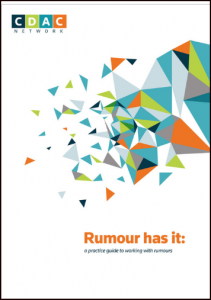Rumour Has It: A Practice Guide to Working with Rumours
The Communicating with Disaster Affected Communities (CDAC) Network recognized the need to work with rumors in their missions to prevent the loss of lives and alleviate suffering. Notably, Internews with their pioneering inter-agency model, the World Health Organisation and United Nations Office for the Coordination of Humanitarian Affairs have made considerable efforts to innovate in this area and engage other humanitarian actors on the issue.
The CDAC Network commissioned a practice guide to draw both on their experiences and many others’ in order to document approaches, practices and tools to working with rumors. It is aimed primarily at humanitarian programme managers and field staff to provide them with practical tips on how to work with rumors in their response programs in a way that is achievable amid competing demands.
- Part One focuses on some of the theory behind rumors: the definition, nature and importance of rumors, and why we need to work with them.
- Part Two explains the key steps and considerations to identifying and addressing rumous: listening, verifying and engaging.
- Part Three examines different roles and responsibilities in working with rumous, and how anticipation, coordination and partnerships can enhance what you do.
The guide is illustrated throughout with experiences from a range of contexts and all of the examples given are based on real rumors. Internews’ model is described in an in-depth case study in the guide, alongside a case study from Search for Common Ground which examines a community-based network approach.
Last modified: February 15, 2020
Language: Arabic, English, French

